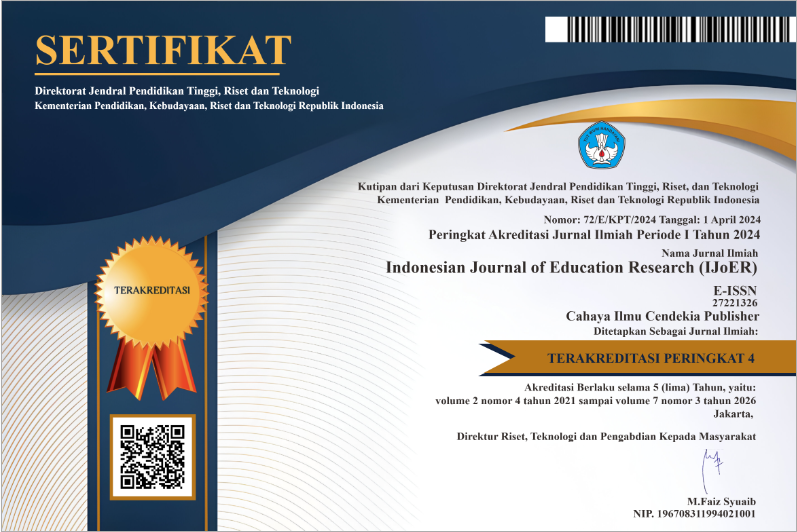Analysis of Students' Multiple Intelligences in Biology Learning Activities
Abstract
Purpose of the study: The research objective was to determine the multiple intelligences of students in biology learning activities for class XII IPA at SMA Negeri 1 Sarolangun Regency.
Methodology: The design used in this research is a descriptive analytic research design. The number of samples in this study were 40 students. The types of data in this study are quantitative and qualitative. The method of collecting data in this study is by interviewing and documentation.
Main Findings: In the Linguistic intelligence indicator, the percentage reached 76.15% in the high category, Mathematical-Logical intelligence reached 75% in the medium category, Visual-Spatial intelligence reached 71% in the medium category, Kinesthetic intelligence reached 67.5% in the medium category, Musical intelligence reached 59% in the high category, Interpersonal intelligence reaches 67.5% in the medium category, Intrapersonal intelligence reaches 74.15% in the medium category, and Naturalist intelligence reaches 81.5% in the high category.
Novelty/Originality of this study: Provide reference material that can be used as material for consideration in developing learning strategies and tools in carrying out learning activities.
References
N. Rohmah, S. Hidayat, And L. Nulhakim, “Implementasi Pendidikan Karakter Disiplin Dalam Mendukung Layanan Kualitas Belajar Siswa,” J. Imiah Pendidik. Dan Pembelajaran, Vol. 5, No. 1, P. 150, 2021, Doi: 10.23887/Jipp.V5i1.30308.
H. Cikaa, “Peranan Kompetensi Guru Pendidikan Agama Islam (Pai) Dalam Meningkatkan Interaksi Pembelajaran Di Sekolah,” Guru Tua J. Pendidik. Dan Pembelajaran, Vol. 3, No. 1, Pp. 43–52, 2020, Doi: 10.31970/Gurutua.V3i1.45.
K. Nisa, “Hidden Curriculum: Upaya Peningkatan Kecerdasan Spiritual Siswa,” Lentera Pendidik. J. Ilmu Tarb. Dan Kegur., Vol. 12, No. 1, Pp. 72–86, 2009, Doi: 10.24252/Lp.2009v12n1a6.
D. Indraswati, A. Widodo, A. N. Rahmatih, M. A. Maulyda, And M. Erfan, “Implementasi Sekolah Ramah Anak Dan Keluarga Di Sdn 2 Hegarsari, Sdn Kaligintung, Dan Sdn 1 Sangkawana,” Jkkp (Jurnal Kesejaht. Kel. Dan Pendidikan), Vol. 7, No. 01, Pp. 51–62, 2020, Doi: 10.21009/Jkkp.071.05.
H. Arifin, “Konsep Multiple Intelligences System Pada Sekolah Menengah Pertama Al Washliyah 8 Medan Dalam Perspektif Islam,” J. Edutech Vol. 3 No. 1 Maret 2017, Vol. 3, No. 1, Pp. 52–73, 2017.
U. Cahyana, M. Paristiowati, M. F. Nurhadi, And S. N. Hasyrin, “Studi Tentang Motivasi Belajar Siswa Pada Penggunaan Media Mobile Game Base Learning Dalam Pembelajaran Laju Reaksi Kimia,” J. Teknol. Pendidik., Vol. 19, No. 2, Pp. 143–155, 2017.
G. Istiningsih, E. M. L.A, And E. Prihalina, “Pengembangan Model Pembelajaran ‘Promister’ Untuk Meningkatkan Hasil Belajar Wayang Pandhawa Pada Siswa Sekolah Dasar,” J. Holistika, Vol. Ii, No. 2, Pp. 94–103, 2018, [Online]. Available: Https://Jurnal.Umj.Ac.Id/Index.Php/Holistika/Article/Download/2637/2788.
S. Nusroh And E. L. F. Ahsani, “Analisis Kesulitan Belajar Pendidikan Agama Islam (Pai) Serta Cara Mengatasinya,” Belajea J. Pendidik. Islam, Vol. 4, No. 2, 2019, Doi: 10.29240/Belajea.V4i2.891.
L. A. Purnama, Sutrisno, And Diana, “Pengaruh Permainan Snowball Drilling Terhadap Kecerdasan Kinestetik Anak Usia 4-5 Tahun Di Tamankanak-Kanaklaboratorium Model Universitas Muhammadiyah Pontianak,” J. Chem. Inf. Model., Vol. 53, No. 9, Pp. 1689–1699, 2016.
F. Oviyanti, “Urgensi Kecerdasan Interpersonal Bagi Guru,” Tadrib J. Pendidik. Agama Islam, Vol. 3, No. 1, P. 75, 2017, Doi: 10.19109/Tadrib.V3i1.1384.
Copyright (c) 2023 Vera Lisnawaty Manik, Idha Nurhayati

This work is licensed under a Creative Commons Attribution-NonCommercial 4.0 International License.
Authors who publish with this journal agree to the following terms:
- Authors retain copyright and acknowledge that the Indonesian Journal of Education Research (IJoER) is the first publisher licensed under a Creative Commons Attribution 4.0 International License.
- Authors are able to enter into separate, additional contractual arrangements for the non-exclusive distribution of the journal's published version of the work (e.g., post it to an institutional repository or publish it in a book), with an acknowledgment of its initial publication in this journal.
- Authors are permitted and encouraged to post their work online (e.g., in institutional repositories or on their website) prior to and during the submission process, as it can lead to productive exchanges and earlier and greater citation of published work.






.png)
.png)




















